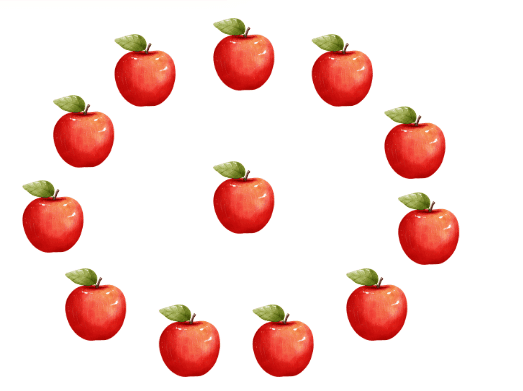Class 4 Maths Word Problems Chapter 3 Patterns Around Us
Q1: Raju arranges 12 apples in a circular pattern with 1 apple in the center and the rest around it. How many apples are in the outer circle?
Sol: Total apples = 12. Apples in the center = 1.
Apples in the outer circle = 12 - 1 = 11. 
Q2: Shirley arranges her coins in groups of 5. If she has 25 coins, how many groups can she make?
Sol: Total coins = 25.
Coins per group = 5.
Number of groups = 25 ÷ 5 = 5. 
Q3: A pattern of shapes repeats as:  What are the next three shapes?
What are the next three shapes?
Sol: The pattern repeats every 3 shapes: star, moon, sun. After sun, the pattern starts again: star, moon, sun.
Q4: Raju has 8 ₹10 notes and 5 ₹2 coins. How much money does he have in total?
Sol: Amount from ₹10 notes = 8 × ₹10 = ₹80.
Amount from ₹2 coins = 5 × ₹2 = ₹10.
Total amount = ₹80 + ₹10 = ₹90.
Q5: Sita arranges 18 candies in groups of 2. Can she distribute them equally? Why or why not?
Sol: Total candies = 18. Candies per group = 2.
18 ÷ 2 = 9 (no remainder).
Since there is no remainder, she can distribute them equally.
Q6: Are the numbers in the times-4 table (4, 8, 12, 16, ...) even or odd?
Sol: Times-4 table:
1 × 4 = 4,
2 × 4 = 8,
3 × 4 = 12,
4 × 4 = 16.
Each number is divisible by 2 (e.g., 4 ÷ 2 = 2, 8 ÷ 2 = 4).
Q7: Using digits 2 and 7, make a 2-digit even number. What is it?
Sol: For a number to be even, the last digit must be even (0, 2, 4, 6, 8).
Digits available: 2 (even), 7 (odd). Possible 2-digit number: 72 (ends in 2).
Q8: A pattern of tiles follows: red, blue, green, red, blue, green. What is the 10th tile?
Sol: The pattern repeats every 3 tiles: red, blue, green. Position 10 ÷ 3 = 3 cycles with 1 tile left (remainder 1). The 1st tile in the cycle is red.
Q9: Are there more even or odd numbers between 1 and 10? Explain.
Sol: Numbers from 1 to 10: 1, 2, 3, 4, 5, 6, 7, 8, 9, 10.
Even numbers: 2, 4, 6, 8, 10 (5 numbers).
Odd numbers: 1, 3, 5, 7, 9 (5 numbers).
⇒ Both have equal numbers.
Q10: A pattern of numbers follows: 5, 10, 15, 20, 25. What are the next two numbers?
Sol: The pattern increases by 5 each time: 5 + 5 = 10, 10 + 5 = 15, etc.
Next number after 25: 25 + 5 = 30.
Next number after 30: 30 + 5 = 35.
|
54 videos|186 docs|14 tests
|
FAQs on Class 4 Maths Word Problems Chapter 3 Patterns Around Us
| 1. What are some common patterns we can find in nature? |  |
| 2. How can we identify patterns in our daily lives? |  |
| 3. Why are patterns important in mathematics? |  |
| 4. How can teachers incorporate patterns into their lessons? |  |
| 5. What activities can help children understand patterns better? |  |
















